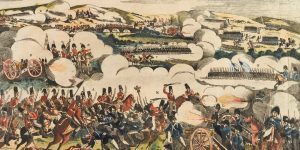We are counting down the days to the anniversary of one of the most monumental battles in the history of the Light Infantry: the Battle of Salamanca. The story of The Battle of Salamanca shows how one little mistake caused so many consequences.
Before we start the story it may interest you to know that this battle took place during the Peninsula War, which began with the French and Spanish invasion of Portugal in 1807.
The main opposition to Lieutenant-General Arthur Wellesley, Viscount Wellington was the widely respected Marshal Auguste de Marmont who was a skilled artillery officer and the commander of the army of Portugal. Wellington’s army consisted of 51,939 men against Mormont’s of 49,647. These figures suggest that Wellington held the advantage with numbers, but 21,359 of the soldiers were unreliable Spanish and Portuguese troops.
Both armies, alike in size and strength, knew it was foolish to risk a full-blown battle, so they stalked and waited for a moment where the opposition were at a disadvantage. Apart from a few skirmishes (episodes of irregular fighting) that broke out on the 18th of July, nothing happened through their 45 mile march towards Salamanca. Sometimes from only a mile distance the two sides watched each other like hawks, each ready to jump at any opportunity in which their enemy was at the disadvantage.

After days of this, Wellington considered retreating out of Portugal and so put all of his troops’ baggage on a train that headed westward. The French clocked this operation as a stage in the complete retreat of the opposing army and planned to cut westward to block their retreat; a huge mistake. However, unknown to Marmont, Wellington was already prepared for this and held back Packenham’s 3rd division. As a consequence of Marmont’s ignorance, the French line became majorly overextended and Wellington seized the chance to attack. He launched a series of hammer blows including Pakenham’s 3rd Division surprising Marmout’s left wing, which was shattered, and then sent in the cavalry brigades to cause further havoc amongst the French lines.
The battle of Salamanca was seen to be one of Wellington’s finest victories. It shows how he swiftly took advantage of a blunder of the opposition and won yet another battle. Salamanca Day also celebrates the Light Infantry as all regiments, apart from Somerset, were involved.

